Controls on Mg/Ca Ratios in Recent Stromatolites: Insights from Fluvial Systems in the Iberian Range (Spain)
Abstract
:1. Introduction
2. Location, Geological Context, Climate and Hydrology
3. Characteristics of Stromatolite Formation in the Studied Rivers
4. Methods
4.1. Sediment Sampling and Analyses
4.2. Water Sampling and Analysis
4.3. Geochemical Modelling Calculations
4.4. Mg/Ca Thermometry
5. Results
5.1. Hydrochemical Characteristics and Mg/Ca Ratios of the Waters
5.2. Geochemical Characteristics and Mg/Ca in Stromatolites
6. Discussion
6.1. (Mg/Ca)calcite and Temperature
6.2. Other Factors That Influence (Mg/Ca)calcite
6.2.1. Mg/Ca of Water
6.2.2. Detrital Minerals
6.2.3. Precipitation Rate
6.2.4. Discharge
6.2.5. Sulphate Content
6.2.6. Biogenic Influence on Stromatolite Mg/Ca
6.3. Differential Behaviours of the Studied Rivers
6.3.1. Añamaza River
6.3.2. Ebrón River
6.3.3. Mesa River
6.3.4. Piedra River
- In the first time interval (from Warm 2004 to Warm 2006), the (Mg/Ca)water values were higher in the warm periods and had lower values in the cool periods (Figure 4), which highlight the temperature-partitioning effect (higher temperatures allow more Mg to enter into the calcite structure). However, the (Mg/Ca)calcite oscillations were small, and thus, the empirical DMg was flattened (Figure 4), which determined that the Mg-derived Tw did not exhibit seasonal changes. Nevertheless, the corresponding Mg-derived Tw was the closest to the measured Tw as compared with the other rivers (Table S3, Supplementary Material). The PWP and sediment thickness values paralleled the Tw, with wide oscillations (Figure 4). Their season-free evolutions were also roughly parallel (Figure 6). Therefore, the (Mg/Ca)calcite maintains the general Tw signature, although the parallel evolution of the (Mg/Ca)water and (Mg/Ca)calcite can erase the six-month changes in the estimated Tw. We found no evidence of detrital Mg in the corresponding sediment.
- In the second time interval (from Cool 2006–2007 to Cool 2009–2010), the (Mg/Ca)water pattern did not match the (Mg/Ca)calcite variation, and it was even opposite to both the calculated and measured Tw. Therefore, the empirical DMg oscillations were amplified by the high (Mg/Ca)water values in the cool periods, when the (Mg/Ca)calcite was lower. The Tw values obtained from this DMg, and from the formula in [45], exhibited the expected six-month oscillations; however, these were systematically higher (Table S3, Supplementary Material) not only in the warm periods, when the estimated DMg was too high, but also in the cool periods, which means that the stromatolite (Mg/Ca)calcite was still higher than it should have been for the (Mg/Ca)water and water temperature at which it was formed. Despite the six-month oscillation of the Mg-derived Tw, the corresponding season-free evolution was not parallel to the measured Tw (Figure 6). Therefore, another control over Mg entry into the calcite lattice has overprinted the influence of temperature on the (Mg/Ca)calcite. The significant correlation between the contents in Al and (Mg/Ca)calcite (Table 3) and the enhanced six-month oscillations of the (Mg/Ca)calcite (with respect to the first time interval) point to the influence of a Mg detrital source.
6.4. Comparison with Other Systems
7. Conclusions
- The degree of the consistency between the Mg-derived water temperatures and measured water temperatures was variable, depending on the studied cases, which indicates that factors other than the temperature influence the (Mg/Ca)calcite. This result is contrary to the high degree of agreement between the δ18O-derived and measured temperatures for the same samples.
- The Mg contents of detrital minerals were responsible for the offset of the Mg-derived water temperatures towards higher values than the measured water temperatures in at least one of the studied rivers (Piedra River), in which the correction of the detrital Mg content yielded water temperatures that matched the measured ones.
- In the three other studied cases, we need to consider the interference of several other factors, either seasonal or not, to explain the lack of agreement between the estimated and measured temperatures, such as the changes in the calcite precipitation rates and water discharges. The seasonal behaviour of the Mgcalcite, and its circumstantial correlation with the temperature, may be due to the influence of other seasonal parameters.
- The presence of noncarbonate Mg (and Ca) minerals, and the occurrence of nonequilibrium conditions in natural systems (e.g., variable flow rates, turbulent flows, the presence of biofilms or plant substrates), substantially limit the use of the (Mg/Ca)cacite as a geochemical thermometer in continental sedimentary environments, except for well-defined systems (e.g., laminar flow, small seasonal variations, and in some hydrothermal systems).
- For the first time, we demonstrate the seasonal variation in the (Mg/Ca)calcite and DMg in fluvial carbonates. Moreover, the seasonal variations in these two parameters are not necessarily associated with the temperature or temperature-dependent parameters, which researchers have recorded in the Piedra River and partially in the Ebrón River stromatolite records.
Supplementary Materials
Author Contributions
Funding
Data Availability Statement
Acknowledgments
Conflicts of Interest
Appendix A. Influence of the Parameters Controlling (Mg/Ca)calcite on the Four Rivers
Appendix A.1. (Mg/Ca)calcite and Measured Tw
Appendix A.2. Mg/Ca of Water
Appendix A.3. Detrital Minerals
- In the RP, the mean DMg decreases from 0.023 to 0.018, and the calculated Mg-derived Tw is 3.7 °C lower. This value cancels out the mean difference between the estimated and measured Tw in the first time interval (from Warm 2004 to Warm 2006) (3.02 °C, Table 2); in the second time interval (from Cool 2006–2007 to Cool 2009–2010), the difference of 7.6 °C is substantially reduced with this correction.
- In the RE, the mean DMg decreases from 0.046 to 0.040, and the calculated Tw is 5 °C lower. These temperatures are still far from the measured ones, which are 27 °C lower as an average. Therefore, a larger amount of detrital matter would be required to fit that value.
- In the RA, the mean DMg decreases from 0.032 to 0.023, and the calculated Tw is 7.4 °C lower. Again, this value is rather behind 13.9 °C, which is the mean difference between the estimated and measured Tw.
- In the RM, the mean DMg decreases from 0.032 to 0.026, and the calculated Tw is 4.2 °C lower than the previously estimated value. This correction does not compensate for the 12.7 °C offset between the measured and calculated Tw.
Appendix A.4. Precipitation Rate
References
- Ihlenfeld, C.; Norman, M.D.; Gagan, M.K.; Drysdale, R.N.; Maas, R.; Webb, J. Climatic significance of seasonal trace element and stable isotope variations in a modern freshwater tufa. Geochim. Cosmochim. Acta 2003, 67, 2341–2357. [Google Scholar] [CrossRef]
- Kawai, T.; Kano, A.; Matsuoka, J.; Ihara, T. Seasonal variation in water chemistry and depositional processes in a tufa-bearing stream in SW-Japan, based on 5 years of monthly observations. Chem. Geol. 2006, 232, 33–53. [Google Scholar] [CrossRef]
- Lojen, S.; Trkov, A.; Scancar, J.; Vázquez-Navarro, J.A.; Cukrov, N. Continuous 60-year stable isotopic and earth-alkali element records in a modern laminated tufa (Jaruga, river Krka, Croatia): Implications for climate reconstruction. Chem. Geol. 2009, 258, 242–250. [Google Scholar] [CrossRef]
- Rogerson, M.; Pedley, H.M.; Wadhawan, J.D.; Middleton, R. New insights into biological influence on the geochemistry of freshwater carbonate deposits. Geochim. Cosmochim. Acta 2008, 72, 4976–4987. [Google Scholar] [CrossRef]
- Brasier, A.T.; Andrews, J.E.; Marca-Bell, A.D.; Dennis, P.F. Depositional continuity of seasonally laminated tufas: Implications for δ18O based palaeotemperatures. Glob. Planet. Change 2010, 71, 160–167. [Google Scholar] [CrossRef]
- Zavadlav, S.; Rožič, B.; Dolenec, M.; Lojen, S. Stable isotopic and elemental characteristics of recent tufa from a karstic Krka River (south-east Slovenia): Useful environmental proxies? Sedimentology 2017, 64, 808–831. [Google Scholar] [CrossRef]
- Saunders, P.; Rogerson, M.; Wadhawan, J.D.; Greenway, G.; Pedley, H.M. Mg/Ca ratios in freshwater microbialcarbonates: Thermodynamic, kinetic and vital effects. Geochim. Cosmochim. Acta 2014, 147, 107–118. [Google Scholar] [CrossRef]
- Ritter, S.M.; Isenbeck-Schröter, M.; Schröder-Ritzrau, A.; Scholz, C.; Rheinberger, S.; Höfle, B.; Frank, N. Trace element partitioning in fluvial tufa reveals variable portions of biologically influenced calcite precipitation. Geochim. Cosmochim. Acta 2018, 225, 176–191. [Google Scholar] [CrossRef]
- Fairchild, I.J.; Borsato, A.; Tooth, A.F.; Frisia, S.; Hawkesworth, C.J.; Huang, Y.-M.; McDermott, F.; Spiro, B. Controls on trace element (Sr-Mg) compositions of carbonate cave waters: Implications for speleothem climatic records. Chem. Geol. 2000, 166, 255–269. [Google Scholar] [CrossRef]
- Pogge von Strandmann, P.; Burton, K.; Snæbjörnsdóttir, S.O.; Sigfusson, B.; Aradottir, E.; Gunnarsson, I.; Alfredsson, H.; Mesfin, K.; Oelkers, E.; Gislason, S. Rapid CO2 mineralisation into calcite at the CarbFix storage site quantified using calcium isotopes. Nat. Commun. 2019, 10, 1983. [Google Scholar] [CrossRef]
- Zhao, M.; Zheng, Y.F.; Zhao, Y. Seeking a geochemical identifier for authigenic carbonate. Nat. Commun. 2016, 7, 10885. [Google Scholar] [CrossRef] [PubMed] [Green Version]
- Rovan, L.; Zuliani, T.; Horvat, B.; Kanduč, T.; Vreča, P.; Jamil, Q.; Čermelj, B.; Bura-Nakić, E.; Cukrov, N.; Štrok, M.; et al. Uranium isotopes as a possible tracer of terrestrial authigenic carbonate. Sci. Total Environ. 2021, 797, 194103. [Google Scholar] [CrossRef]
- Osácar, M.C.; Arenas, C.; Auqué, L.; Sancho, C.; Pardo, G.; Vázquez-Urbez, M. Discerning the interactions between environmental parameters reflected in δ13C and δ18O of recent fluvial tufas: Lessons from a Mediterranean climate región. Sediment. Geol. 2016, 345, 126–144. [Google Scholar] [CrossRef] [Green Version]
- Vera, J.A. Geología de España; SGE-IGME: Madrid, Spain, 2004; p. 884. [Google Scholar]
- Lozano, M.V.; Sancho, C.; Arenas, C.; Vázquez-Urbez, M.; Ortiz, J.E.; Torres, T.; Pardo, G.; Osácar, M.C.; Auqué, L. Analisis preliminar de las tobas cuaternarias del Río Ebrón (Castielfabib, Valencia, Cordillera Ibérica). Geogaceta 2012, 51, 51–54. [Google Scholar]
- Vázquez-Úrbez, M.; Arenas, C.; Pardo, G. A sedimentary facies model for stepped, fluvial tufa systems in the Iberian Range (Spain): The Quaternary Piedra and Mesa valleys. Sedimentology 2012, 59, 502–526. [Google Scholar] [CrossRef]
- Rico, M.T.; Sancho-Marcén, C.; Arenas-Abad, M.C.; Vázquez-Urbez, M.; Valero-Garcés, B.L. El sistema de barreras tobáceas Holocenas de las Parras de Martín (Cordillera Ibérica, Teruel). Cuad. Investig. Geogr. 2013, 39, 141–158. [Google Scholar] [CrossRef] [Green Version]
- Luzón, M.A.; Pérez, A.; Borrego, A.G.; Mayayo, M.J.; Soria, A.R. Interrelated continental sedimentary environments in the central Iberian Range (Spain): Facies characterization and main palaeoenvironmental changes during the Holocene. Sediment. Geol. 2011, 239, 87–103. [Google Scholar] [CrossRef]
- Arenas, C.; Vázquez-Urbez, M.; Auqué, L.; Sancho, C.; Osácar, M.C.; Pardo, G. Intrinsic and extrinsic controls of spatial and temporal variations in modern fluvial tufa sedimentation: A thirteen-year record from a semi-arid environment. Sedimentology 2014, 61, 90–132. [Google Scholar] [CrossRef] [Green Version]
- Osácar, C.; Arenas, C.; Vázquez-Urbez, M.; Sancho, C.; Auqué, L.F.; Pardo, G. Environmental factors controlling the δ13C and δ18O variations of recent fluvial tufas: A 12-year record from the Monasterio de Piedra Natural Park (NE Iberian Peninsula). J. Sediment. Res. 2013, 83, 309–322. [Google Scholar] [CrossRef]
- Arenas, C.; Auqué, L.; Osácar, M.C.; Sancho, C.; Lozano, M.V.; Vázquez-Urbez, M.; Pardo, G. Current tufa sedimentation in a high discharge river: A comparison with other synchronous tufa records in the Iberian Range (Spain). Sediment. Geol. 2015, 325, 132–157. [Google Scholar] [CrossRef]
- Auqué, L.; Arenas, C.; Osácar, M.C.; and Pardo, G.; Sancho, C.; Vázquez-Urbez, M. Tufa sedimentation in changing hydrological conditions: The River Mesa (Spain). Geol. Acta 2013, 11, 85–102. [Google Scholar]
- Auqué, L.; Arenas, C.; Osácar, C.; Pardo, G.; Sancho, C.; Vázquez-Urbez, M. Current tufa sedimentation in a changing-slope valley: The River Añamaza (Iberian Range, NE Spain). Sediment. Geol. 2014, 303, 26–48. [Google Scholar] [CrossRef]
- Pentecost, A. Travertine; Springer: Berlin/Heidelberg, Germany; New York, NY, USA,, 2005; 445p. [Google Scholar]
- Vázquez-Urbez, M.; Arenas, C.; Sancho, C.; Osácar, C.; Auqué, L.; Pardo, G. Factors controlling present-day tufa dynamics in the Monasterio de Piedra Natural Park (Iberian Range, Spain): Depositional environmental settings, sedimentation rates and hydrochemistry. Int. J. Earth Sci. 2010, 99, 1027–1049. [Google Scholar] [CrossRef]
- Arenas, C.; Jones, B. Temporal and environmental significance of microbial lamination: Insights from Recent fluvial stromatolites in the River Piedra, Spain. Sedimentology 2017, 64, 1597–1629. [Google Scholar] [CrossRef]
- Beraldi-Campesi, H.; Arenas-Abad, C.; Garcia-Pichel, F.; Arellano-Aguilar, O.; Auque, L.; Vazquez-Urbez, M.; Sancho, C.; Osácar, C.; Ruiz-Velasco, S. Benthic bacterial diversity from freshwater tufas of the Iberian Range (Spain). FEMS Microbiol. Ecol. 2012, 80, 363–379. [Google Scholar] [CrossRef] [PubMed]
- Berrendero, E.; Arenas, C.; Matero, P.; Jones, B. Cyanobacterial diversity and related sedimentary facies as a function of water flow conditions: Example from the Monasterio de Piedra Natural Park (Spain). Sediment. Geol. 2016, 337, 12–28. [Google Scholar] [CrossRef]
- Arenas, C.; Osácar, C.; Sancho, C.; Vázquez-Urbez, M.; Auqué, L.; Pardo, G. Seasonal record from recent fluvial tufa deposits (Monasterio de Piedra, NE Spain): Sedimentological and stable isotope data. Geol. Soc. Lond. Spec. Publ. 2010, 336, 119–142. [Google Scholar] [CrossRef]
- Moore, D.M.; Reynolds, R.C., Jr. X-ray Diffraction and the Identification and Analysis of Clay Minerals, 2nd ed.; Oxford University Press: Oxford, UK, 1997; pp. xvii + 378. [Google Scholar]
- Hillier, S. Quantitative Analysis of Clay and Other Minerals in Sandstones by X-ray Powder Diffraction (XRPD). In Clay Minerals Cements in SANDSTONES. Int. Assoc. Sedimento; Worden, R.H., Morad, S., Eds.; Blackwell Science Ltd.: Hoboken, NJ, USA, 2003; Volume 34, pp. 213–251. [Google Scholar]
- Parkhurst, D.L.; Appelo, C.A.J. Description of Input and Examples for PHREEQC Version 3. A Computer Program for Speciation, Batch Reaction, One Dimensional Transport, and Inverse Geochemical Calculations. In Techniques and Methods, Book 6, Chap. A43; U.S. Geological Survey, Ed.; U.S. Geological Survey: Denver, CO, USA, 2013; 497p. Available online: https://www.usgs.gov/software/phreeqc-version-3 (accessed on 28 December 2022).
- Plummer, L.N.; Wigley, T.M.L.; Parkhurst, D.L. The kinetics of calcite dissolution in CO2–water system at 5° to 60 C and 0.0 to 1.0 atm CO2. Am. J. Sci. 1978, 278, 179–216. [Google Scholar] [CrossRef]
- Kaufmann, G.; Dreybrodt, W. Calcite dissolution kinetics in the system CaCO3–H2O–CO2 at high undersaturation. Geochim. Cosmochim. Ac. 2007, 71, 1398–1410. [Google Scholar] [CrossRef]
- Reddy, M.M.; Plummer, L.N.; Busenberg, E. Crystal growth of calcite from calcium bicarbonate solutions at constant PCO2 and 25 °C: A test of a calcite dissolution model. Geochim. Cosmochim. Acta 1981, 45, 1281–1289. [Google Scholar] [CrossRef]
- Lorah, M.M.; Herman, J.S. The chemical evolution of a travertine depositing stream: Geochemical processes and mass transfer reactions. Water Resour. Res. 1988, 24, 1541–1552. [Google Scholar] [CrossRef]
- Dreybrodt, W.; Buhmann, D.; Michaelis, J.; Usdowski, E. Geochemically controlled calcite precipitation by CO2 outgassing: Field measurements of precipitation rates in comparison to theoretical predictions. Chem. Geol. 1992, 97, 285–294. [Google Scholar] [CrossRef]
- Liu, Z.; Svensson, U.; Dreybrodt, W.; Yuan, D.; Buhmann, D. Hydrodynamic control of inorganic calcite precipitation in Huanglong ravine, China: Field measurements and theoretical prediction of deposition rates. Geochim. Cosmochim. Acta 1995, 59, 3087–3097. [Google Scholar]
- Kano, A.; Matsuoka, J.; Kojo, T.; Fujii, H. Origin of annual laminations in tufa deposits, southwest Japan. Palaeogeogr. Palaeocl. Palaeoecol. 2003, 191, 243–262. [Google Scholar] [CrossRef]
- Kano, A.; Hagiwara, R.; Kawai, T.; Hori, M.; Matsuoka, J. Climatic conditions and hydrological change recorded in a high-resolution stable-isotope profile of a recent laminated tufa on a subtropical island, southern Japan. J. Sediment. Res. 2007, 77, 59–67. [Google Scholar] [CrossRef]
- Kawai, T.; Kano, A.; Hori, M. Geochemical and hydrological controls on biannual lamination of tufa deposits. Sediment. Geol. 2009, 213, 41–50. [Google Scholar] [CrossRef]
- Shiraishi, F.; Reimer, A.; Bisset, A.; de Beer, D.; Arp, G. Microbial effects on biofilm calcification, ambient water chemistry and stable isotope records in a highly supersaturated setting (Westerhöfer Bach, Germany). Palaeogeogr. Palaeocl. Palaeoecol. 2008, 262, 91–106. [Google Scholar] [CrossRef]
- Dreybrodt, W.; Buhmann, D. A mass transfer model for dissolution and precipitation of calcite from solutions in turbulent motion. Chem. Geol. 1991, 90, 107–122. [Google Scholar] [CrossRef]
- Lu, G.; Zheng, C.; Donahoe, R.J.; Lyons, B.W. Controlling processes in a CaCO3 precipitating stream in Huanglong Natural Scenic District, Sichuan, China. J. Hydrol. 2000, 230, 34–54. [Google Scholar] [CrossRef]
- Huang, Y.M.; Fairchild, I.J. Partitioning of Sr2+ and Mg2+ into calcite under karst-analogue experimental conditions. Geochim. Cosmochim. Acta 2001, 65, 47–62. [Google Scholar] [CrossRef]
- Day, C.C.; Henderson, G.M. Controls on trace-element partitioning in cave-analogue calcite. Geochim. Cosmochim. Acta 2013, 120, 612–627. [Google Scholar] [CrossRef]
- O’Brien, G.R.; Kaufman, D.S.; Sharp, W.D.; Atudorei, V.; Parnell, R.A.; Crossell, L.J. Oxygen isotope composition of annually banded modern and mid-Holocene travertine and evidence of paleomonsoon floods, Grand Canyon, Arizona, USA. Quat. Res. 2006, 65, 366–379. [Google Scholar] [CrossRef]
- Özkul, M.; Gökgöz, A.; Horvatinčić, N. Depositional properties and geochemistry of Holocene perched springline tufa deposits and associated spring waters: A case study from the Denizli Province, Western Turkey. In Tufas and Speleothems: Unravelling the Microbial and Physical Controls; Pedley, H.M., Rogerson, M., Eds.; Geological Society: London, UK, 2010; Volume 336, pp. 245–262. [Google Scholar]
- Dabkowski, J.; Limondin-Lozouet, N.; Andrews, J.; Marca-Bell, A.; Antoine, A. Climatic and environmental variations during the last interglacial recorded in a Northern France tufa (Caours, Somme basin). Comparisons with regional records. Quaternaire 2016, 27, 249–261. [Google Scholar] [CrossRef]
- Dabkowski, J.; Frodlová, J.; Hájek, M.; Hájková, P.; Petr, L.; Fiorillo, D.; Dudová, L.; Horsák, M. A complete Holocene climate and environment record for the Western Carpathians (Slovakia) derived from a tufa deposit. Holocene 2018, 29, 493–504. [Google Scholar] [CrossRef]
- Mavromatis, V.; Gautier, Q.; Bosc, O.; Schott, J. Kinetics of Mg partition and Mg stable isotope fractionation during its incorporation in calcite. Geochim. Cosmochim. Acta 2013, 114, 188–203. [Google Scholar] [CrossRef]
- Wassenburg, J.A.; Riechelman, S.; Schoder-Ritzrau, A.; Riechelman, D.F.C.; Richter, D.K.; Immenhauser, A.; Terente, M.; Constantin, S.; Hachenberg, A.; Hansen, M.; et al. Calcite Mg and Sr partition coefficients in cave environments: Implications for interpreting prior calcite precipitation in speleothems. Geochim. Cosmochim. Acta 2020, 269, 581–596. [Google Scholar] [CrossRef]
- Garnett, E.R.; Andrews, J.E.; Preece, R.C.; Dennis, P.F. Climatic change recorded by stable isotopes and trace elements in a British Holocene tufa. J. Quat. Sci. 2004, 19, 251–262. [Google Scholar] [CrossRef]
- Rogerson, M.; Pedley, H.M.; Greenway, G.M.; Wadhawan, J.D. Interaction of temperature, salinity and extracellular polymeric substances controls trace element incorporation into tufa calcite. Depos. Rec. 2022, 8, 210–219. [Google Scholar] [CrossRef]
- Sironić, A.; Barešić, J.; Horvatinčić, N.; Brozinčević, A.; Vurnek, M.; Kapelj, S. Changes in the geochemical parameters of karst lakes over the past three decades. The case of Plitvice Lakes, Croatia. Appl. Geochem. 2017, 78, 12–22. [Google Scholar] [CrossRef]
- Karmann, I.; Cruz, F.W., Jr.; Viana, O., Jr.; Burns, S.J. Climate influence on geochemistry parameters of waters from Santana–Pérolas cave system, Brazil. Chem. Geol. 2007, 244, 232–247. [Google Scholar] [CrossRef]
- Fairchild, I.J.; Treble, P.C. Trace elements in speleothems as recorders of environmental change. Quat. Sci. Rev. 2009, 28, 449–468. [Google Scholar] [CrossRef]
- Rimstidt, J.D.; Balog, A.; Webb, J. Distribution of trace elements between carbonate minerals and aqueous solutions. Geochim. Cosmochim. Acta 1998, 62, 1851–1863. [Google Scholar] [CrossRef]
- Walter, L.M. Relative efficiency of carbonate dissolution and precipitation during diagenesis: A progress report on the role of solution chemistry. In Roles of Organic Matter in Sediment Diagenesis; Gautier, D.L., Ed.; Society of Economic Paleontologists and Mineralogists Special Publication: Tulsa, OK, USA, 1986; Volume 38, pp. 1–11. [Google Scholar]
- Sheikholeslami, R.; M. Ng. Calcium Sulfate Precipitation in the Presence of Nondominant Calcium Carbonate: Thermodynamics and Kinetics. Ind. Eng. Chem. Res. 2001, 40, 3570–3578. [Google Scholar] [CrossRef]
- Flaathen, T.K.; Oelkers, E.H.; Gislason, S.R.; Aagaard, P. The effect of dissolved sulphate on calcite precipitation kinetics and consequences for subsurface CO2 storage. Enrgy. Proced. 2011, 4, 5037–5043. [Google Scholar] [CrossRef] [Green Version]
- Mejri, W.; Korchef, A.; Tlili, M.; Ben Amor, M. Effects of temperature on precipitation kinetics and microstructure of calcium carbonate in the presence of magnesium and sulphate ions. Desalin. Water Treat. 2014, 52, 25–27. [Google Scholar] [CrossRef]
- Cuesta-Mayorga, I.; Astilleros, J.M. Fernández-Díaz, L Precipitation of CaCO3 Polymorphs from Aqueous Solutions: The Role of pH and Sulphate Groups. Minerals 2019, 9, 178. [Google Scholar] [CrossRef] [Green Version]
- Domínguez-Villar, D.; Vázquez-Navarro, J.A.; Krklec, K. The role of gypsum and/or dolomite dissolution in tufa precipitation: Lessons from the hydrochemistry of a carbonate-sulphate karst system. Earth Surf. Proc. Land. 2017, 42, 245–258. [Google Scholar] [CrossRef]
- Olsson, J.; Stipp, S.L.S.; Makovicky, E.; Gislason, S.R. Metal scavenging by calcium carbonate at the Eyjafjallajökull volcano: A carbon capture and storage analogue. Chem. Geol. 2014, 384, 135–148. [Google Scholar] [CrossRef] [Green Version]
- Asta, M.P.; Auqué, L.F.; Sanz, F.J.; Gimeno, M.J.; Acero, P.; Blasco, M.; García-Alix, A.; Gómez, J.; Delgado-Huertas, A.; Mandado, J. Travertines associated with the Alhama-Jaraba thermal Waters (NE, Spain): Genesis and geochemistry. Sediment. Geol. 2017, 347, 100–116. [Google Scholar] [CrossRef] [Green Version]
- Gascoyne, M. Trace-element partition coefficients in the calcite-water system and their paleoclimatic significance in cave studies. J. Hydrol. 1983, 61, 213–222. [Google Scholar] [CrossRef]
- Riechelmann, D.F.C.; Deininger, M.; Scholz, D.; Riechelmann, S. Schröder-Ritzrau, A.; Spötl, C.; Richter, D.K.; Mangini, A.; Immenhauser, A. Disequilibrium carbon and oxygen isotope fractionation in recent cave calcite: Comparison of cave precipitates and model data. Geochim. Cosmochim. Acta 2013, 103, 232–244. [Google Scholar] [CrossRef]
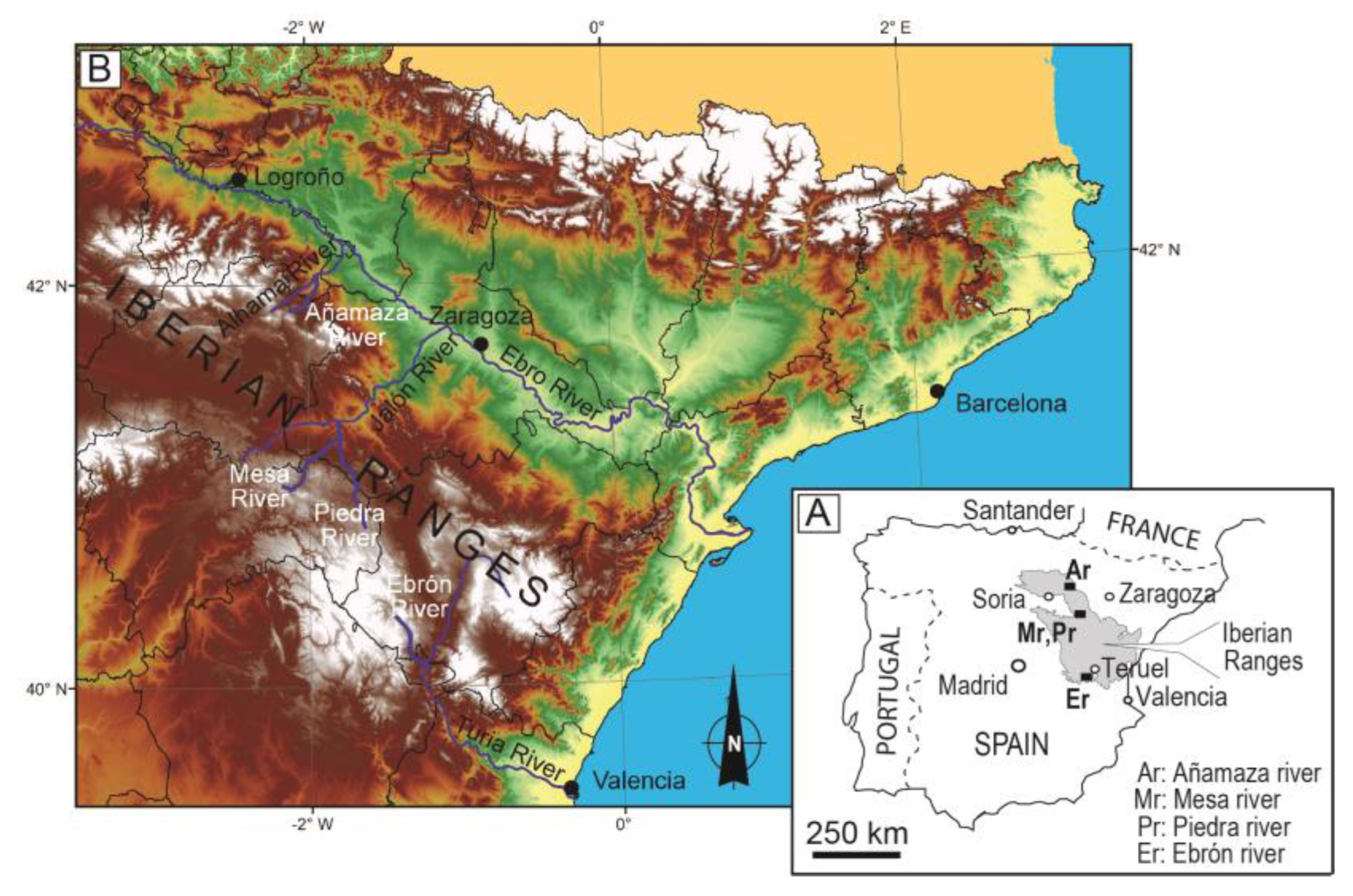
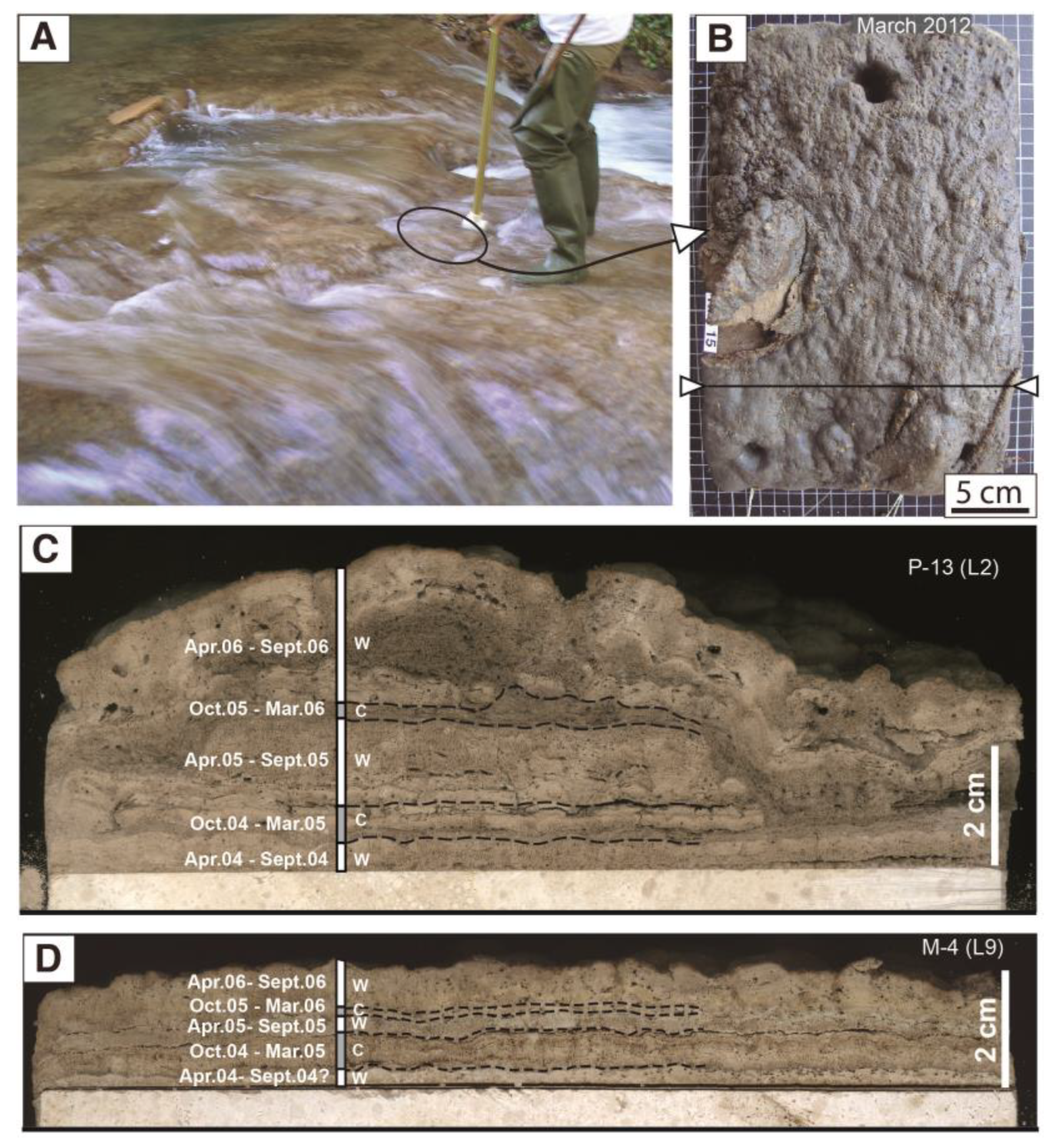
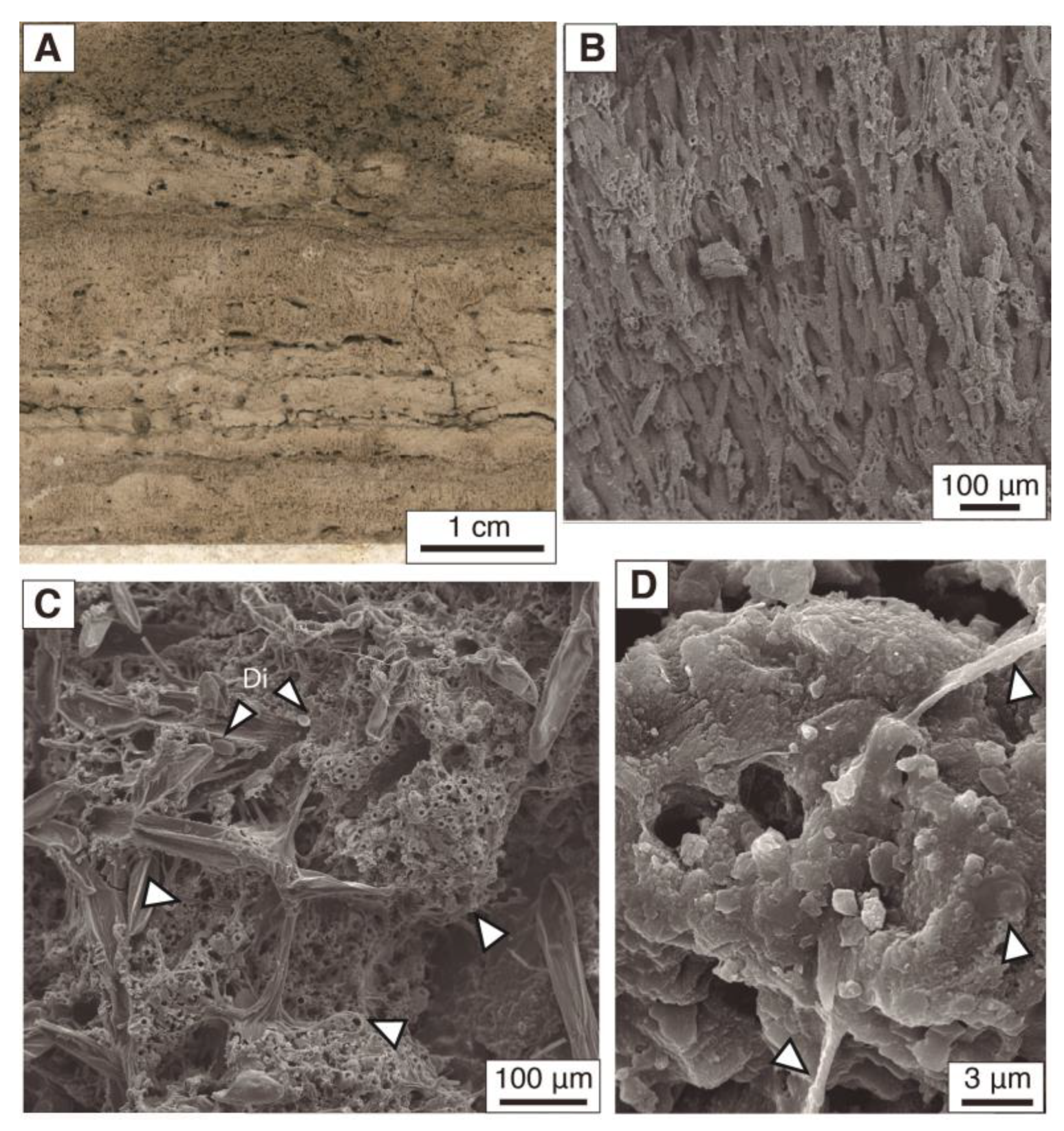

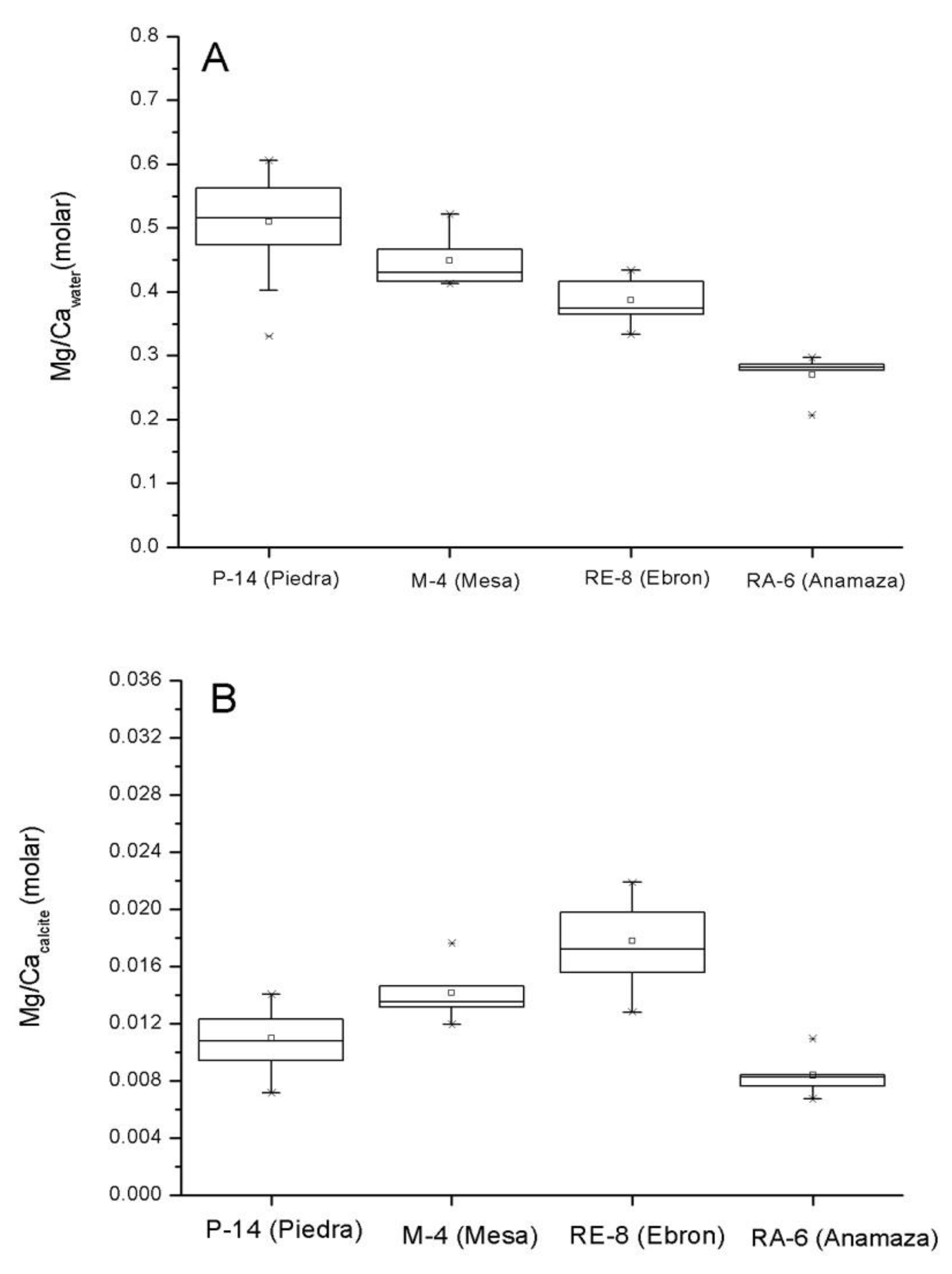
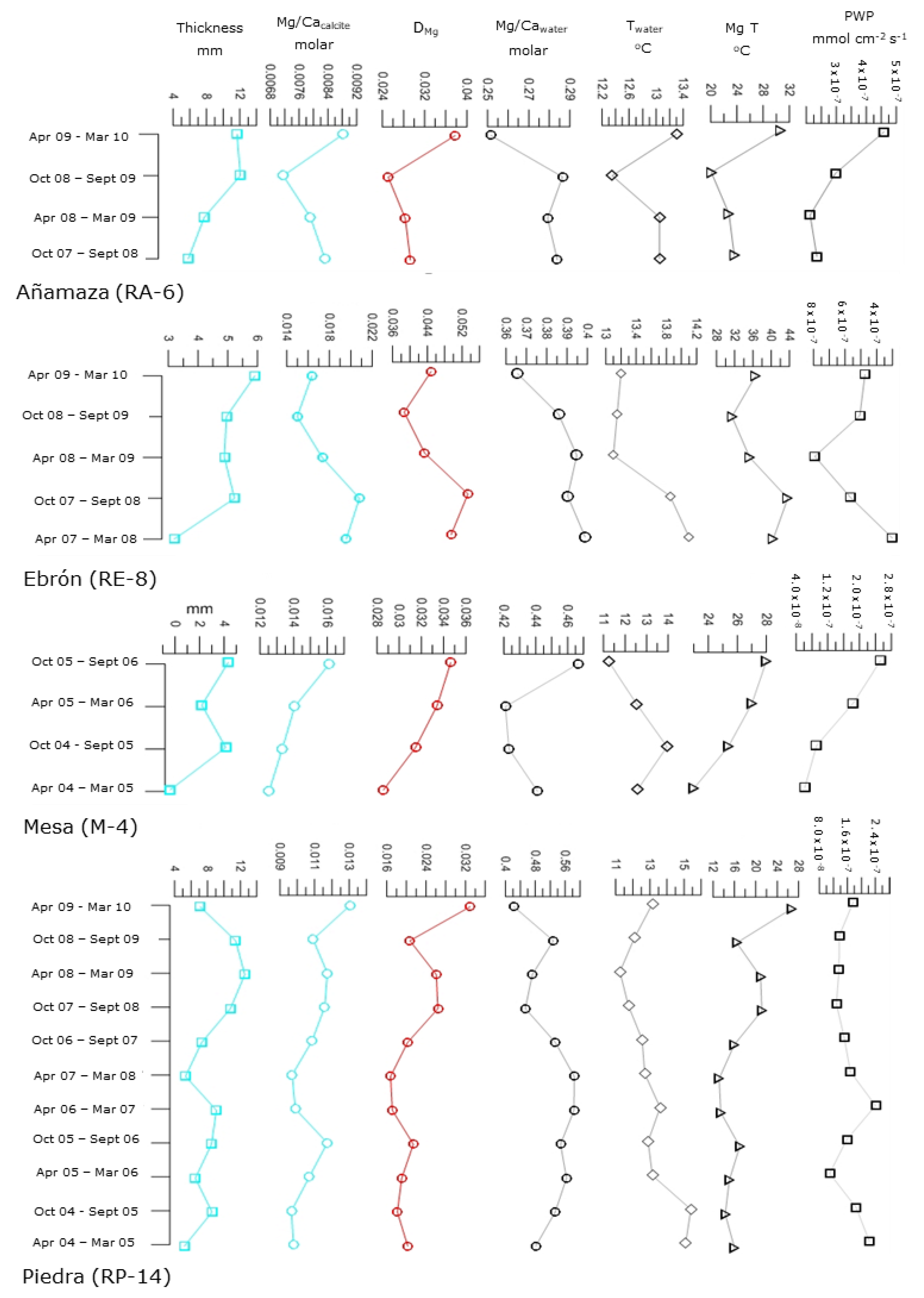
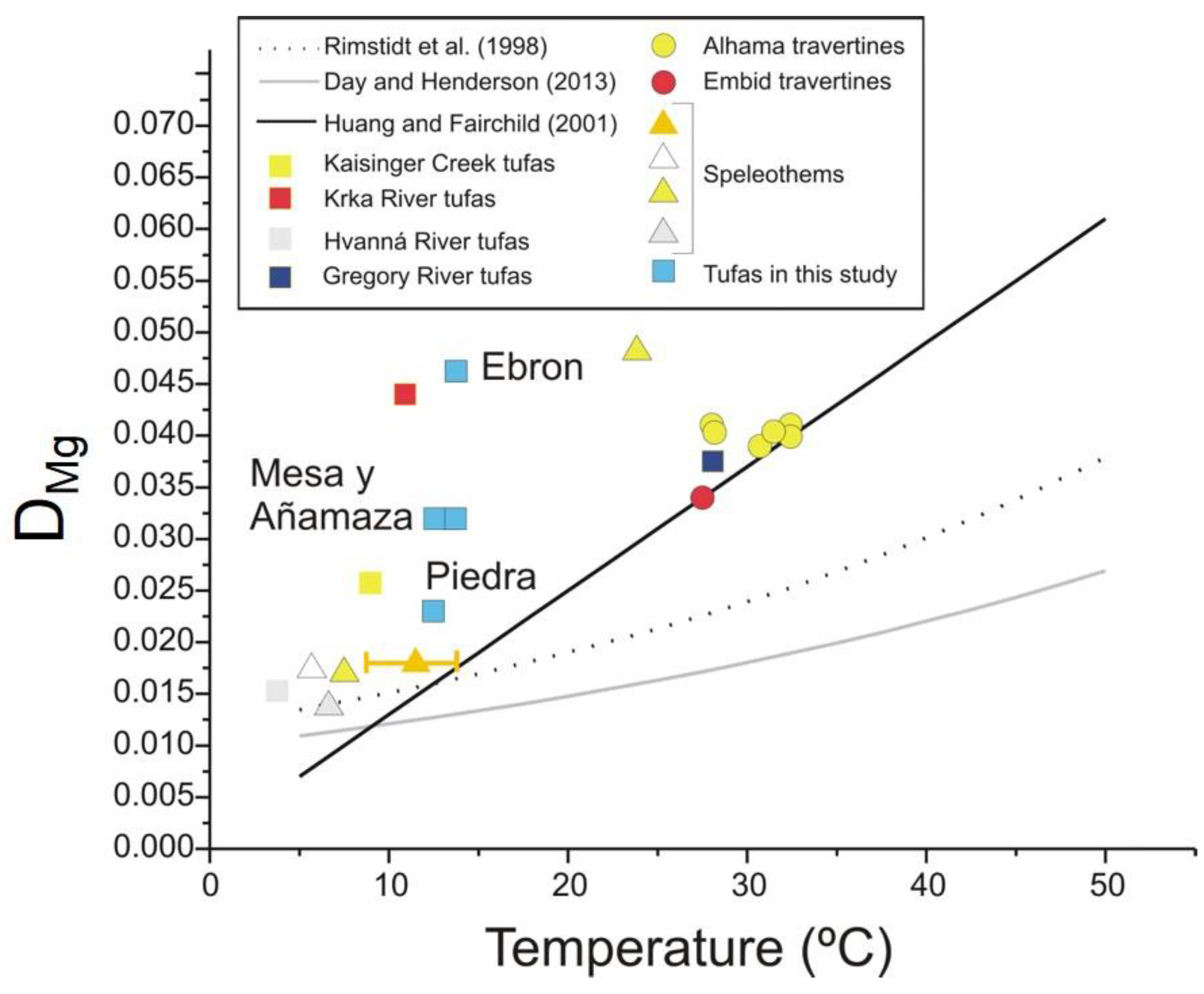
| Chemical Components | Piedra River | Mesa River | Añamaza River | Ebrón River | Kaisinger Creek | Krka (2) River |
|---|---|---|---|---|---|---|
| Mgwater (mmol/L) | 1.04 ± 0.19 | 0.87 ± 0.034 | 0.87 ± 0.07 | 0.80 ± 0.054 | 0.32 ± 0.03 | 0.94 ± 0.15 |
| Cawater (mmol/L) | 2.04 ± 0.17 | 1.95 ± 0.22 | 3.24 ± 0.23 | 2.08 ± 0.17 | 3.16 ± 0.23 | 1.66 ± 0.1 |
| Mg/Cawater (molar) | 0.51 ± 0.08 | 0.449 ± 0.045 | 0.27 ± 0.036 | 0.386 ± 0.033 | 0.101 ± 0.01 | 0.56 ± 0.08 |
| Cacalcite (wt%) | 37.0 ±2.56 | 35.2 ± 0.97 | 34.05 ± 2.08 | 34.8 ±2.53 | 37.1 ± 0.99 | 34.02 ±1.04 |
| Mgcalcite (g/kg) | 2.46 ± 0.47 | 3.01 ± 0.38 | 1.73 ± 0.31 | 3.75 ± 0.8 | 0.58 ± 0.05 | 5.48 ± 0.71 |
| Mg/Cacalcite (molar) | 0.011 ± 0.002 | 0.014 ± 0.002 | 8.38 × 10−3 ± 1.6 × 10−3 | 0.018 ± 0.004 | 2.58 × 10−3 ± 0.27 × 10−3 | 0.027 ± 0.004 |
| DMg | 0.023 ± 0.008 | 0.032 ± 0.04 | 0.032 ± 0.012 | 0.046 ± 0.009 | 0.025 ± 0.003 (1) | 0.044 ± 0.0068 |
| River (Number of Samples) | Mg/Cawater vs. T | Mg/Catufa vs. T | Mg/Catufa vs. Mg/Cawater | DMg vs. T | PWP vs. T | Tcalc-T measured Mean |
|---|---|---|---|---|---|---|
| Piedra (n = 12) | +0.15 (p = 0.627) | +0.391 (p = 0.208) | −0.577 (p = 0.049) | +0.064 (p = 0.845) | +0.863 (p = 0.0003) | 4.89 |
| Piedra Cool 06-07 to Cool 09-10 (n = 5) | −0.03 (p = 0.945) | 0.576 (p = 0.176) | −0.787 (p = 0.036) | 0.213 (p = 0.646) | +0.842 (p = 0.017) | +7.57 |
| Piedra Warm 04 to Warm 06 (n = 7) | +0.346 (p = 0.568) | + 0.379 (p = 0.529) | 0.587 (p = 0.298) | 0.27 (p = 0.66) | +0.967 (p = 0.007) | +1.15 |
| Añamaza (n = 5) | +0.326 (p = 0.59) | −0.338 (p = 0.577) | −0.939 (p = 0.018) | −0.312 (p = 0.608) | +0.39 (p = 0.516) | 13.9 |
| Mesa (n = 56) | +0.479 (p = 0.414) | −0.023 (p = 0.971) | +0.61 (p = 0.273) | −0.48 (p = 0.40) | −0.663 (p = 0.222) | 12.5 |
| Ebrón (n = 6) | +0.892 (p = 0.017) | +0.691 (p = 0.128) | +0.551 (p = 0.256) | +0.269 (p = 0.28) | +0.103 (p = 0.845) | 24.0 |
| River | Mg/Catufa | Al Contents in Tufas | Mg and Al Contents in Tufas | Correlation Coefficient (R, Pearson) for Al vs Mg/Ca (2) in Tufas | ||
|---|---|---|---|---|---|---|
| All Periods | Warm 04 to Warm 06 | Cool 2006–07 to Cool 2009–10 | ||||
| Piedra | Almost seasonal (1) | Not seasonal | Al > Mg | 0.598 | 0.055 | 0.756 |
| Ebron | Almost seasonal (1) | Almost seasonal (1) | Al > Mg | +0.88 | ||
| Añamaza | Not seasonal | Seasonal (2) | Al > Mg | +0.965 | ||
| Mesa | Not seasonal | Almost seasonal (2) | Mg ≈ Al | +0.93 | ||
Disclaimer/Publisher’s Note: The statements, opinions and data contained in all publications are solely those of the individual author(s) and contributor(s) and not of MDPI and/or the editor(s). MDPI and/or the editor(s) disclaim responsibility for any injury to people or property resulting from any ideas, methods, instructions or products referred to in the content. |
© 2022 by the authors. Licensee MDPI, Basel, Switzerland. This article is an open access article distributed under the terms and conditions of the Creative Commons Attribution (CC BY) license (https://creativecommons.org/licenses/by/4.0/).
Share and Cite
Auqué, L.F.; Osácar, M.C.; Arenas, C.; Cukrov, N.; Lojen, S.; Sancho, C. Controls on Mg/Ca Ratios in Recent Stromatolites: Insights from Fluvial Systems in the Iberian Range (Spain). Minerals 2023, 13, 57. https://doi.org/10.3390/min13010057
Auqué LF, Osácar MC, Arenas C, Cukrov N, Lojen S, Sancho C. Controls on Mg/Ca Ratios in Recent Stromatolites: Insights from Fluvial Systems in the Iberian Range (Spain). Minerals. 2023; 13(1):57. https://doi.org/10.3390/min13010057
Chicago/Turabian StyleAuqué, Luis F., M. Cinta Osácar, Concha Arenas, Neven Cukrov, Sonja Lojen, and Carlos Sancho. 2023. "Controls on Mg/Ca Ratios in Recent Stromatolites: Insights from Fluvial Systems in the Iberian Range (Spain)" Minerals 13, no. 1: 57. https://doi.org/10.3390/min13010057
APA StyleAuqué, L. F., Osácar, M. C., Arenas, C., Cukrov, N., Lojen, S., & Sancho, C. (2023). Controls on Mg/Ca Ratios in Recent Stromatolites: Insights from Fluvial Systems in the Iberian Range (Spain). Minerals, 13(1), 57. https://doi.org/10.3390/min13010057







